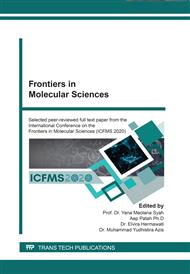[1]
P. Siahaan, R. Christian, A.N. Fauziah, D. Hudiyanti, V.D. Prasasty, Ab-initio computational study of noncovalent interaction between peptide and alkaline metal ions on HF/6-31 G∗∗ level, AIP Conf. Proc. 2049 (2018). https://doi.org/10.1063/1.5082458.
DOI: 10.1063/1.5082458
Google Scholar
[2]
C. Rajesh, C. Majumder, H. Mizuseki, Y. Kawazoe, A theoretical study on the interaction of aromatic amino acids with graphene and single walled carbon nanotube, J. Chem. Phys. 130 (2009). https://doi.org/10.1063/1.3079096.
DOI: 10.1063/1.3079096
Google Scholar
[3]
A. Alaofi, E. Farokhi, V.D. Prasasty, A. Anbanandam, K. Kuczera, T.J. Siahaan, Probing the interaction between cHAVc3 peptide and the EC1 domain of E-cadherin using NMR and molecular dynamics simulations, J. Biomol. Struct. Dyn. 35 (2017) 92–104. https://doi.org/10.1080/07391102.2015.1133321.
DOI: 10.1080/07391102.2015.1133321
Google Scholar
[4]
G. Meng, K. Fütterer, Donor substrate recognition in the raffinose-bound E342A mutant of fructosyltransferase Bacillus subtilis levansucrase, BMC Struct. Biol. 8 (2008) 16. https://doi.org/10.1186/1472-6807-8-16.
DOI: 10.1186/1472-6807-8-16
Google Scholar
[5]
G.H. Peters, O.H. Olsen, A. Svendsen, R.C. Wade, Theoretical investigation of the dynamics of the active site lid in Rhizomucor miehei lipase, Biophys. J. 71 (1996) 119–129. https://doi.org/10.1016/S0006-3495(96)79207-X.
DOI: 10.1016/s0006-3495(96)79207-x
Google Scholar
[6]
S. Bhuvanendran, N.A. Hanapi, N. Ahemad, I. Othman, S.R. Yusof, M.F. Shaikh, Embelin, a potent molecule for Alzheimer's disease: A proof of concept from blood-brain barrier permeability, acetylcholinesterase inhibition and molecular docking studies, Front. Neurosci. 13 (2019) 1–10. https://doi.org/10.3389/fnins.2019.00495.
DOI: 10.3389/fnins.2019.00495
Google Scholar
[7]
B. Safitri, D. Hudiyanti, M.D. Laksitorini, N.A. Sasongko, P. Siahaan, Intermolecular hydrogen bond interactions in N -carboxymethyl chitosan and n H2O: DFT and NBO studies, AIP Conf. Proc. 2237 (2020). https://doi.org/10.1063/5.0005287.
DOI: 10.1063/5.0005287
Google Scholar
[8]
P. Singla, M. Riyaz, S. Singhal, N. Goel, Theoretical study of adsorption of amino acids on graphene and BN sheet in gas and aqueous phase with empirical DFT dispersion correction, Phys. Chem. Chem. Phys. 18 (2016) 5597–5604. https://doi.org/10.1039/c5cp07078c.
DOI: 10.1039/c5cp07078c
Google Scholar
[9]
P. Siahaan, N.E. Darmastuti, S. Aisyafalah, N.A. Sasongko, D. Hudiyanti, M. Asy'ari, V.D. Prasasty, Probing the interaction between EC1-EC2 domain of E-cadherin with conformational structure of cyclic ADTC7 (Ac-CDTPDC-NH 2 ) peptide using molecular docking approach , J. Phys. Conf. Ser. 1524 (2020) 12081. https://doi.org/10.1088/1742-6596/1524/1/012081.
DOI: 10.1088/1742-6596/1524/1/012081
Google Scholar
[10]
P. Atkins, J. de Paula, J. Keeler, Atkins' PHYSICAL CHEMISTRY, 2018. https://doi.org/10.1017/CBO9781107415324.004.
Google Scholar
[11]
A.H.C. Horn, Essentials of Computational Chemistry, Theories and Models By Christopher J. Cramer. Wiley: Chichester, England. 2002. 562 pp. ISBN 0-471-48551-9 https://doi.org/10.1021/ci010445m.
DOI: 10.1021/ci010445m
Google Scholar
[12]
Kohn, Walter, Nobel lecture: Electronic structure of matter-wave functions and density functionals, Rev. Mod. Phys. 71 (1999) 1253–1266. https://doi.org/S0034-6861(99)00505-X.
DOI: 10.1103/revmodphys.71.1253
Google Scholar
[13]
Y. Zhao, D.G. Truhlar, Exploring the limit of accuracy of the global hybrid meta density functional for main-group thermochemistry, kinetics, and noncovalent interactions, J. Chem. Theory Comput. 4 (2008) 1849–1868. https://doi.org/10.1021/ct800246v.
DOI: 10.1021/ct800246v
Google Scholar
[14]
R. Peverati, D.G. Truhlar, Quest for a universal density functional: The accuracy of density functionals across a broad spectrum of databases in chemistry and physics, Philos. Trans. R. Soc. A Math. Phys. Eng. Sci. 372 (2014). https://doi.org/10.1098/rsta.2012.0476.
DOI: 10.1098/rsta.2012.0476
Google Scholar
[15]
M. Isegawa, R. Peverati, D.G. Truhlar, Performance of recent and high-performance approximate density functionals for time-dependent density functional theory calculations of valence and Rydberg electronic transition energies, J. Chem. Phys. 137 (2012). https://doi.org/10.1063/1.4769078.
DOI: 10.1063/1.4769078
Google Scholar
[16]
M.D. Sweeney, A.P. Sagare, B. V. Zlokovic, Blood-brain barrier breakdown in Alzheimer disease and other neurodegenerative disorders, Nat. Rev. Neurol. 14 (2018) 133–150. https://doi.org/10.1038/nrneurol.2017.188.
DOI: 10.1038/nrneurol.2017.188
Google Scholar
[17]
R.A. Lusiana, V.D.A. Sangkota, N.A. Sasongko, G. Gunawan, A.R. Wijaya, S.J. Santosa, D. Siswanta, M. Mudasir, M.N.Z. Abidin, S. Mansur, M.H.D. Othman, Permeability improvement of polyethersulfone-polietylene glycol (PEG-PES) flat sheet type membranes by tripolyphosphate-crosslinked chitosan (TPP-CS) coating, Int. J. Biol. Macromol. 152 (2020) 633–644. https://doi.org/10.1016/j.ijbiomac.2020.02.290.
DOI: 10.1016/j.ijbiomac.2020.02.290
Google Scholar
[18]
Sally A. Kim, C.-Y. Tai, L.-P. Mok, E.A. Mosser, E.M. Schuman, Calcium-dependent dynamics of cadherin interactions at cell-cell junctions, Natl. Acad. Sci. 108 (2017) 2017. https://doi.org/10.1073/pnas.
DOI: 10.1073/pnas.1019003108
Google Scholar
[19]
D.A. Schultz, A.M. Friedman, M.A. White, R.O. Fox, The crystal structure of the cis -proline to glycine variant (P114G) of ribonuclease A , Protein Sci. 14 (2005) 2862–2870. https://doi.org/10.1110/ps.051610505.
DOI: 10.1110/ps.051610505
Google Scholar
[20]
I. Stavropoulos, K. Golla, N. Moran, F. Martin, D.C. Shields, Cadherin juxtamembrane region derived peptides inhibit TGFβ1 induced gene expression, Bioarchitecture. 4 (2014) 103–110. https://doi.org/10.4161/bioa.32143.
DOI: 10.4161/bioa.32143
Google Scholar
[21]
Z. Jing, R. Qi, C. Liu, P. Ren, Study of interactions between metal ions and protein model compounds by energy decomposition analyses and the AMOEBA force field, J. Chem. Phys. 147 (2017). https://doi.org/10.1063/1.4985921.
DOI: 10.1063/1.4985921
Google Scholar
[22]
E. Scoppola, A. Sodo, S.E. McLain, M.A. Ricci, F. Bruni, Water-peptide site-specific interactions: A structural study on the hydration of glutathione, Biophys. J. 106 (2014) 1701–1709. https://doi.org/10.1016/j.bpj.2014.01.046.
DOI: 10.1016/j.bpj.2014.01.046
Google Scholar
[23]
N.A. Sasongko, P. Siahaan, R.A. Lusiana, V. Prasasty, Understanding the interaction of polysulfone with urea and creatinine at the molecular level and its application for hemodialysis membrane, J. Phys. Conf. Ser. 1524 (2020) 12084. https://doi.org/10.1088/ 1742-6596/1524/1/012084.
DOI: 10.1088/1742-6596/1524/1/012084
Google Scholar
[24]
H.D. Nguyen, A.J. Marchut, C.K. Hall, Solvent effects on the conformational transition of a model polyalanine peptide, Protein Sci. 13 (2008) 2909–2924. https://doi.org/10.1110/ ps.04701304.
DOI: 10.1110/ps.04701304
Google Scholar


